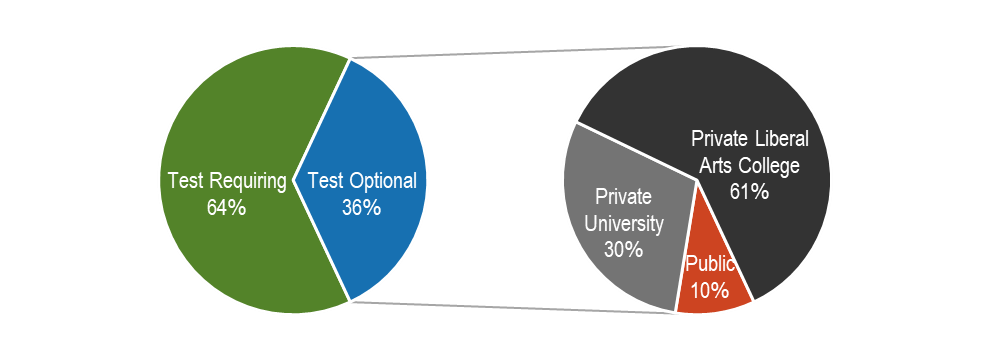How do Test-Optional or Test-Flexible Policies Affect Access and Opportunity?
By Sindy Lopez and James Dean Ward
December 18, 2019
This post originally appeared on the Ithaka S+R blog.
Reading Time: 7 minutes

A growing number of institutions have adopted or are considering test-optional or -flexible policies in recent years. Most recently, leaders of the University of California and several of its campuses have publicly discussed removing standardized test scores as an application requirement due to the perception that standardized tests are inherently biased against underserved students. Such a large system of selective institutions moving away from standardized tests would represent a dramatic shift in the higher education ecosystem. Although the number of institutions going test-optional is growing, there is also a limited understanding of the effects these policies have on access, equity, and an institution’s operations
The American Talent Initiative (ATI), a coalition of high-graduation-rate colleges and universities committed to enrolling and graduating more low- and middle-income students, recently hosted a webinar for members to discuss research, examples, and practical considerations regarding test-optional or test-flexible policies. In this blog post, we discuss the motivations behind test-optional or test-flexible policies, the current research landscape, and key takeaways from the webinar.
What is the definition of test-optional or test-flexible?
Test-optional policies allow prospective students to choose whether or not to submit their SAT or ACT scores as part of their application process. When applicants do not include test scores, institutions rely on other academic aspects of the application to make admissions decisions. Test-flexible policies allow prospective students to submit different types of test scores as part of their application.
Why might a selective institution consider a test-optional or test–flexible policy?
Currently, most four-year postsecondary institutions use standardized tests as part of their admissions process. In 2019, over 2.2 million students took the SAT while more than 1.78 million students took the ACT test. The SAT and ACT have retained their place in the admissions process because they allow for a standardized comparison of student academic performance in a way that high school GPA and other measures may not.
Some contend that the predictive validity of the SAT and ACT is limited to narrow, short-term outcomes like success in first-year courses, and do not reflect important capacities like motivation and intellectual curiosity. Moreover, SAT and ACT scores are strongly correlated with race and socioeconomic status, in part because they can be improved through test preparation and multiple sittings, advantages to which wealthier students have much greater access. These links have led to equity concerns that relying on standardized admissions tests may replicate inequalities in higher education. These concerns and others have led some four-year institutions to reduce the role of the SAT and ACT in their admissions decisions through test-optional or test-flexible policies. They have also led the College Board, which manages the SAT, to develop strategies intended to promote equity, such as free test preparation services and a dashboard presenting contextual information about test-takers’ high school and neighborhood characteristics. The ACT also provides some free preparation materials online and if a student receives a fee waiver for the exam, they are granted free access to ACT preparation materials that are usually available for purchase.
What is the current landscape of test-optional institutions?
According to FairTest, more than 1,000 colleges have de-emphasized standardized tests through test-optional or -flexible policies. Currently, about 36 percent of the 320 ATI-eligible institutions have implemented a test-optional or -flexible policy, as shown in Figure 1. Ninety-one percent of ATI-eligible colleges and universities that have adopted test-optional or -flexible policies are private; this includes 70 private liberal arts colleges and 34 private research universities. Since 2005, more than 90 ATI eligible schools have adopted these types of policies, 43 in the past five years (see Figure 2 below).
Figure 1: ATI eligible Institutions with Test Requiring and Test-Optional or -Flexible Policies

Figure 2: ATI Eligible Institutions Adopting Test-Optional or -Flexible Policies (2005-2019)

How do test-optional policies affect the applicant pool?
An institution’s applicant pool generally grows after implementing a test-optional or -flexible policy. A study of liberal arts colleges found that institutions received 220 more applications, on average, after adopting a test-optional policy. This work is bolstered by other findings that suggest an application increase of 29 percent at private institutions and 11 percent at public institutions.
Additionally, several studies found that applicants who did not submit test scores were more likely to be underrepresented minorities, first-generation, Pell-eligible, and women. Students who do not submit test scores also are likely to have slightly lower first year and cumulative college GPAs compared to students who do submit test scores. Non-submitters were often admitted at lower rates than students who submitted their standardized test scores. However, if non-submitters gained admission, they generally enrolled at higher rates than submitters did.
How do test-optional policies affect underrepresented student enrollment?
In one study, roughly 60 percent of the test-optional institutions experienced increases in enrollment of underrepresented students compared to their test requiring peers, while about 50 percent saw an increase in enrollment of Pell recipients. One study on how test-optional policies may affect college enrollments found that adopting a test-optional policy, generally, could increase racial and socioeconomic diversity. However, the effects of such a policy would likely depend on institutional characteristics (e.g., endowment size, selectivity, sector, or geography).
A study examining 180 selective liberal arts colleges found that adopting test-optional policies did not increase racial or socioeconomic diversity. After adopting test-optional policies, the liberal arts colleges in the study received an increased number of applications thus decreasing their acceptance rates. The authors suggest the change in perceived selectivity may dissuade historically underserved students from applying. Additionally, de-emphasizing test scores may lead admissions officers to rely more heavily on supplementary materials and extracurricular activities, which may privilege wealthy students who have more access and ability to develop a compelling resume. Furthermore, implementing a test-optional or -flexible policy without changing need-aware admissions or financial aid budgets may not alter the fundamental ways that institutions make decisions regarding admissions and ability to pay.
How do test-optional policies affect institutional finances?
Although not conclusive, one study found that, following the adoption of a test-optional policy, the proportion of enrolled students with need did not increase. However, the average amount of demonstrated need among enrolled students increased, as did the amount of institutional grants and scholarships the institution awarded. The authors did find non-submitters generally had more financial need. However, these institutions also increased their sticker price. Although the colleges increased the amount of aid awarded, students are unaware of this until after they have already applied and been admitted. While increased aid may induce more low-income students to enroll, researchers suggest that the higher list price may dissuade low-income students from applying in the first place. This may be limiting the potential positive impacts a test-optional policy can have on racial and socioeconomic diversity.
What strategies have institutions used to implement a test-optional or -flexible policy?
Before implementing test-optional or -flexible policies, some institutions have conducted pilot programs or internal studies to determine whether these types of policies would fundamentally change the undergraduate student profile of the institutions. Institutions have engaged their stakeholders and campus communities to communicate how these policies can increase college access and opportunity. Through these discussions and simulation studies, campus leaders can build the necessary support to implement a test-optional policy.
George Mason University and Worcester Polytechnic University (WPI) are two examples of a public and a private institution that took a strategic approach to developing and implementing these types of policies with the intention to increase college access for underrepresented students. To provide guidance to other campuses that may seek to develop a test-optional policy, each shared insights from their experience on the ATI webinar, focusing on the implementation process, lessons learned, and effects of adopting a test-optional or -flexible policy.
George Mason University
George Mason University, the largest, public, comprehensive, research university in the Commonwealth of Virginia, offers an innovative and inclusive academic community, steeped in a mission of access where students come first. During Fall 2007, George Mason implemented its score optional policy during as a pilot with applicants who were students in the District of Columbia Public Schools. George Mason’s score optional policy allows students with strong academic performance and demonstrated leadership and motivation to apply without submitting ACT or SAT scores. It began this pilot because administrators found that high-achieving students with lower standardized test scores were not being admitted, even though they could be successful at George Mason. The pilot study found that non-submitters usually had average first year college GPAs that were slightly higher than first year students who submitted test scores.
As the pilot program evolved, George Mason administrators relied on the overall rigor of an applicant’s curriculum, relative to their grades, to assess their ability to be successful at the institution, rather than using definitive class rank or high school GPA cutoffs. Since the adoption of the score optional policy, the percent of prospective students applying score optional composed 15-17 percent of the applicant pool for fall 2019.
The George Mason presenter explained that without support from a broad coalition, a test-optional policy could face pushback from senior leadership and alumni due to concerns that a test-optional policy can lead to enrolling students that are less prepared academically. The results from the pilot study and the commitment to a more thorough evaluation of test-optional applicants helped build support for the policy across campus.
Worcester Polytechnic University (WPI)
WPI adopted a test optional policy in 2007, becoming the first nationally ranked science and engineering-focused university to do so. The WPI Admissions staff identified misperceptions on the part of students, parents and guidance counselors regarding the role that standardized test scores played in the selection process. Standardized test scores seemed to be a barrier for underserved students in particular, with many prospective students self-selecting out of the application pool due to the assumption that they needed high math scores to gain admission. The WPI Admissions leadership and a faculty governance committee undertook a three-year intensive review to determine whether test scores accurately predicted academic success, which resulted in a strong vote of support from the faculty and from the Student Government Association in favor of a test optional admissions policy.
Since the adoption of the policy, WPI has seen applications from women and underrepresented students more than double. Enrollment of women and underrepresented students has increased by 81 percent and 156 percent, respectively. Analyses since the change have found no statistically significant difference in retention or graduation rates between non-submitters and submitters. Like the presenters from George Mason, WPI administrators stressed the importance of institutional engagement and cultivating buy-in from faculty, administrators, and students, as well as evaluation of the effects of the policy on applications and enrollment of underrepresented students, as instrumental to the success of their test-optional policy. WPI uses ongoing evaluations of the policy’s effect on applications and enrollment of underrepresented students to continue monitoring the effectiveness and sustain support across campus.
Are there additional considerations that should be taken into account before implementing a test-optional or -flexible policy?
Colleges can take many different approaches to implementing a test-optional policy. Some spend years developing pilot programs where others may swiftly enact a top-down mandate. However, the research and discussion during the webinar surfaced several important considerations institutions should take into account as they consider test-optional policies:
- Adopting a test-optional policy may boost the academic profile of an institution, as only reported test scores are used to calculate averages. However, this may have the unintended consequence of dissuading historically underserved students from applying due to perceived selectivity.
- Supplementary materials can replace test scores in the application process; however, it is important to note that supplementary applications may also pose barriers for low-income and underrepresented students who do not necessarily have the resources to develop these other aspects of an application.
- It may take more time to review applications holistically. Admissions officers will likely spend more time evaluating applicants’ curricula, high school characteristics, and supplemental materials.
- Alumni, faculty, and other key stakeholders may have different reactions to the implementation of a test-optional policy. For example, some stakeholders may perceive test-optional policies as loosening standards, and therefore detrimental to the reputation of the institution.
- Institutions should consider how diversifying their enrollment via a test-optional policy might affect financial aid budgets. Additionally, if an institution maintains a need-aware admissions policy, it should contemplate how this might interact with a test-optional policy.
While there is a solid base of research on standardized tests, in general, less is known about the effects of test-optional policies. As a growing number of selective institutions adopt or consider test-optional policies as a means of increasing access for historically underserved students, it is important for college leaders to understand what the research does say, and to think critically about how their particular campus may be impacted by such policies. Given the uncertainty, being purposeful and transparent, and building and maintaining support across campus as well as an understanding of the facts through outreach, pilot studies, and continued evaluation, can help an institution successfully develop and implement a test-optional or -flexible policy.
We invite readers to share their thoughts on how test-optional or test-flexible policies can affect access and opportunity.




